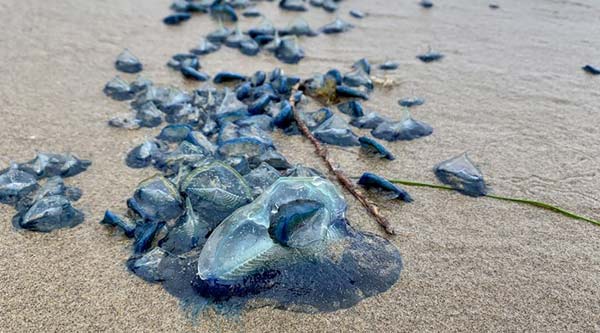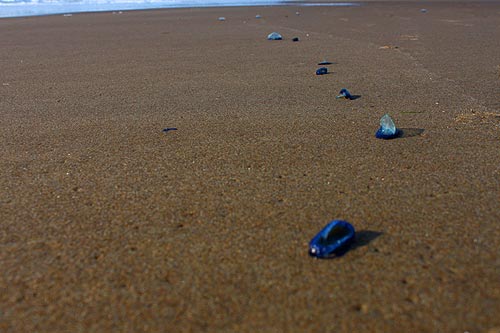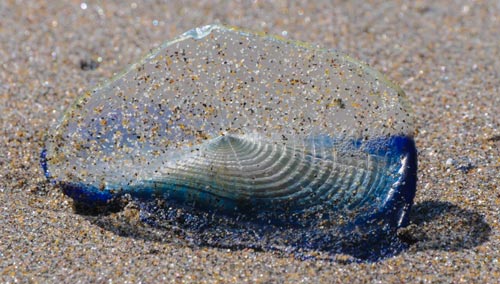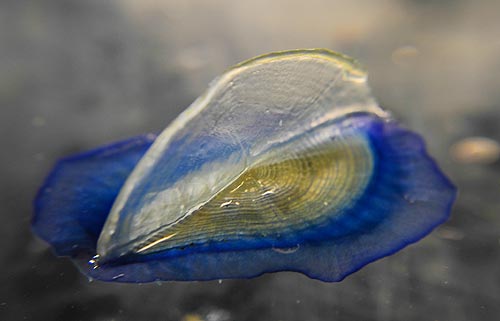Strange Blue Velella Velella Return to Oregon Coast, Some Spots Thicker Than Others
Published 06/03/2019 at 5:53 AM PDT
By Oregon Coast Beach Connection staff

Includes exclusive listings; some specials in winter
In Cannon Beach:
Includes rentals not listed anywhere else
In Manzanita, Wheeler, Rockaway Beach:
Some specials for winter
In Pacific City, Oceanside:
Some specials for winter
In Lincoln City:
Some specials for winter
In Depoe Bay, Gleneden Beach:
Some specials for winter
In Newport:
Look for some specials
In Waldport
Some specials for winter
In Yachats, Florence
Some specials for winter
(Oregon Coast) – The alerts are going out: the blue tide has come in. The Oregon coast is getting hit by another wave of little blue creatures called velella velella (or Purple Sailors or by-the-wind Sailors). Newport’s Oregon Coast Aquarium, Cannon Beach’s Haystack Rock Awareness Program and the volunteer program CoastWatch are heralding the return up and down the shoreline. (Photo above: Cannon Beach area, courtesy Haystack Rock Awareness Program).
The jelly-like creatures can be enormous in number, but some places are getting hit harder than others. One report came from Neskowin claiming only one example was found, while Cannon Beach is getting a fair amount and parts of the Newport to Waldport areas have received many.
They showed up in April already, but in fewer numbers and not very large. That indicates juveniles, rather than the bigger examples now being found.
Oregon Coast Aquarium was the among the first to send out the heads up.
“By-the-wind-sailors are hydrozoans, a class of predatory animals, distantly related to corals, sea anemones and jellies,” the aquarium said. “They range in size from a few millimeters across to seven centimeters and appear brilliant blue and purple when at sea or freshly washed ashore. After time in the sun, the Velella dry out and lose their pigmentation. Beachgoers will often mistake the dried animals for thin, clear pieces of plastic.”
You’ll notice the clear, triangular sail at the top of the creature, which is strangely enough its only means of moving around. These creatures begin popping up when west winds kick in and the right currents have brought them closer to shore. They have no real means of propelling themselves, so they are at the mercy of the winds. If it's westerly winds pushing onshore for awhile, the seas draw them onto the sands of the Oregon coast.
They are called by-the-wind-sailors for a reason.
The aquarium in Newport said that this side of the north Pacific Ocean has them evolved in a certain way. The sails are set in a northwest-to-southeast direction to take advantage of regional wind patterns. With gentle winds, Velella sail at about a 45-degree angle in front of the wind, aiming always to be blown away from shore.
Thus, at the mercy of sometimes erratic winds along the west coast, you may see mass strandings for miles. They can sometimes completely carpet the area in layers. However, that isn’t happening now. They’re thick in spots, but not for miles on end.
Problems start when they don’t get washed away, and if they’re around long enough they begin to stink badly.
Like the bizarre pyrosomes that washed up periodically in recent years, these are also comprised of tiny colonies of other animals. It turns out they are not singular animals at all, according to the aquarium.

“Each Velella is a colony of all-male or all-female individuals (called polyps), which are divided into separate groups within the colony,” the aquarium said. “Some polyps specialize in feeding and reproduction, while others protect the colony and provide structural support.”
Velella velella are capable of stinging – but not humans. They sting their smaller prey such as plankton with barb-tipped cells contained within their tentacles. That venom is not considered dangerous to humans, although the public is still urged to not touch them because some humans may be more prone to reaction, just like some have allergies to certain substances.
Another issue is these are simply dead and decaying creatures on the beaches, which could be a health hazard. Oregon Coast Hotels for this event - Where to eat - Map - Virtual Tour
Velella photos below courtesy Seaside Aquarium:
Cannon Beach Lodging
Nehalem Bay Lodgings
Manzanita Hotels, Lodging
Three Capes Lodging
Pacific City Hotels, Lodging
Lincoln City Lodging
Depoe Bay Lodging
Newport Lodging
Waldport Lodging
Yachats Lodging
Oregon Coast Vacation Rentals
Oregon Coast Lodging Specials



More About Oregon Coast hotels, lodging.....
More About Oregon Coast Restaurants, Dining.....
LATEST Related Oregon Coast Articles
Through 2 a.m. likely best, but some lights possible through dawn June 1 - 2. Space weather, astronomy
Rare Sperm Whale Stranding on N. Oregon Coast, Was Hit by Boat
Showing up near Gearhart, it will decompose naturally. Marine sciences
Coast Guard Barque 'America's Tall Ship' Coming to Portland Rose Fest, N. Ore...
Portland events: June 5 - 8; Astoria events June 13 - 15. Weather
Bright and Active Arietids Meteors May Hit Pre-Dawn Hours of Oregon, Washingt...
Look to east hour before sunrise and you may catch a show. Sciences, astronomy, weather
Why Now Could Be a Great Week for Spotting Killer Whales on Oregon Coast - Video
A good dozen documentations around Depoe Bay, Newport, Coos Bay, Bandon, Tillamook. Marine sciences
Summer Road Work, Traffic Issues Along Oregon Coast Include Astoria, Garibald...
Some daylight closures include bridges, OR 22, OR 18, OR 26, more. Travel tips. Seaside, Cannon Beach, Lincoln City. Travel tips
Pacific City Oregon Weather, 7-Day Forecasts, Live Conditions, Radar, Webcams...
Updated Constantly: Pacific City, Tierra Del Mar, Oregon Weather, Cams, Buoy Observations, Tides, Warnings - Alerts
Oregon Coast Has World's Oldest Harbor Seal, Celebrating 50 Years Soon
June 3 at Oregon Coast Aquarium in Newport. Newport events
Back to Oregon Coast
Contact Advertise on BeachConnection.net
All Content, unless otherwise attributed, copyright BeachConnection.net Unauthorized use or publication is not permitted















































